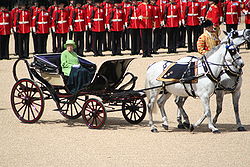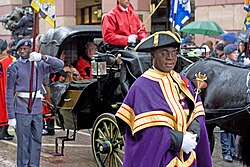
A carriage is a private four-wheeled vehicle for people and is most commonly horse-drawn. Second-hand private carriages were common public transport, the equivalent of modern cars used as taxis. Carriage suspensions are by leather strapping or, on those made in recent centuries, steel springs. Two-wheeled carriages are informal and usually owner-driven.
Master of the Horse is an official position in several European nations. It was more common when most countries in Europe were monarchies, and is of varying prominence today.

A mews is a row or courtyard of stables and carriage houses with living quarters above them, built behind large city houses before motor vehicles replaced horses in the early twentieth century. Mews are usually located in desirable residential areas, having been built to cater for the horses, coachmen and stable-servants of prosperous residents.

The Irish State Coach is an enclosed, four-horse-drawn carriage used by the British Royal Family. It is the traditional horse-drawn coach in which the British monarch travels from Buckingham Palace to the Palace of Westminster to formally open the new legislative session of the UK Parliament.
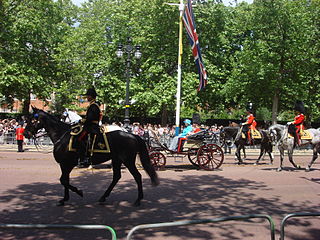
The Crown Equerry is the operational head of the Royal Mews of the Royal Household of the Sovereign of the United Kingdom. As executive head of the Royal Mews Department, he is responsible for the provision of vehicular transport for the sovereign, both cars and horse-drawn carriages. Train travel is arranged by the Royal Travel Office, which also co-ordinates air transport.

The Bentley State Limousines are official state cars manufactured by Bentley as a gift for the late Queen Elizabeth II on the occasion of her Golden Jubilee in 2002. The two cars produced were in service for the Queen up until her death in 2022. They have most recently been in service for King Charles III. The Princess Royal used the car while accompanying the Queen's coffin. Both cars are kept in the Royal Mews.

The Scottish State Coach is an enclosed, four-horse-drawn carriage used by the British Royal Family.

The Rolls-Royce Phantom IV is a British automobile produced by Rolls-Royce. Only eighteen were made between 1950 and 1956, sold only to buyers whom Rolls-Royce considered worthy of the distinction: the British royal family and heads of state. Sixteen are known to still exist in museums as well as in public and private collections.

A horse-drawn vehicle is a piece of equipment pulled by one or more horses. These vehicles typically have two or four wheels and were used to carry passengers or a load. They were once common worldwide, but they have mostly been replaced by automobiles and other forms of self-propelled transport but are still in use today.

Hooper & Co. was a British coachbuilding business for many years based in Westminster London. From 1805 to 1959 it was a notably successful maker, to special order, of luxury carriages, both horse-drawn and motor-powered.

Windsor Grey is a moniker for the grey horses used by the British monarchy to pull carriages in ceremonial processions such as those for coronations, royal weddings, Trooping the Colour, and the opening of Parliament. They are named for Windsor Castle where they were originally stabled, though today they live at the Royal Mews near Buckingham Palace.
An official state car is a vehicle used by a government to transport its head of state or head of government in an official capacity, which may also be used occasionally to transport other members of the government or visiting dignitaries from other countries. A few countries bring their own official state car for state visits to other countries, for instance, the United States, Russia, the United Kingdom, South Korea, Germany and Japan. It also may serve as an automotive symbol of the head of state and their country. An official state car must have adequate security, capability and stateliness for its duty. A limousine or other high-end vehicle is usually selected.
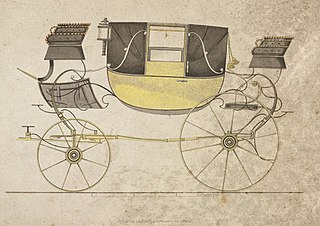
In coachbuilding, a landau is a four-wheeled carriage with a roof that can be let down. It was a luxury carriage. The low shell of the landau provides maximal visibility of the occupants and their clothing, a feature that makes a landau still a popular choice for Lord Mayors in the United Kingdom on ceremonial occasions.

A coach is a large, closed, four-wheeled, passenger-carrying vehicle or carriage usually drawn by two or more horses controlled by a coachman, a postilion, or both. A coach has doors in its sides and a front and a back seat inside. The driver has a raised seat in front of the carriage to allow better vision. It is often called a box, box seat, or coach box. There are many of types of coaches depending on the vehicle's purpose.

The Australian State Coach is an enclosed, six horse-drawn coach used by the British Royal Family. Constructed in 1986-88, it was the first royal state coach to have been built since 1902. It was presented to Queen Elizabeth II of Australia and the United Kingdom in Canberra on 8 May 1988, as the official gift on the occasion of the Australian Bicentennial, and was first used in November of that year by the Queen at the State Opening of Parliament in the UK.

A brougham was originally a car body style where the driver sat outside and passengers seated within an enclosed cabin, — deriving the configuration from the earlier brougham horse-drawn carriage. Similar in style to the later town car, the brougham style was used on chauffeur-driven petrol and electric cars.

The Royal Stables is the mews of the Danish monarchy which provides the ceremonial transport for the Danish royal family during state events and festive occasions. The Royal Stables are located at Christiansborg Palace on the island of Slotsholmen in central Copenhagen, Denmark. In 1789, the number of horses reached a peak with 270 horses stabled. Nowadays, there are about 20 horses in the Royal Stables.

The Royal Stables is the mews of the Swedish Monarchy which provides both the ceremonial transport for the Swedish Royal Family during state events and festive occasions and their everyday transportation capacity. The Royal Stables date from 1535, and were originally built on Helgeandsholmen, close to Stockholm Palace. The Royal Stables are today located just behind Strandvägen in Östermalm in central Stockholm, Sweden. The head of the Royal Stables is the Crown Equerry.

The state and royal cars of the United Kingdom are kept at the Royal Mews, Buckingham Palace, where a wide range of state road vehicles are kept and maintained. The vehicles also are stored at other royal residences as required.
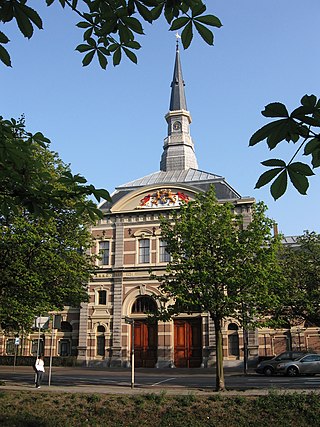
The Royal Stables is a collection of equestrian stables of the Dutch royal family, the House of Orange-Nassau. It is a Rijksmonumental building that is part of the royal palace grounds located in the city center of The Hague in the Netherlands. The Noordeinde Palace and the Palace Gardens are also part of this same palace complex. The Noordeinde Palace and its grounds are the official workplace of the Dutch King Willem-Alexander.










